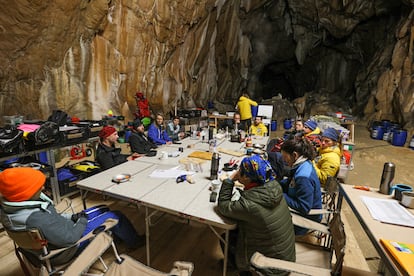First was the bewilderment.
People who have just emerged from the cave after 40 days locked up were convinced that they had spent less time inside.
One person believed that the confinement had lasted 23 days.
Another 30, or 32. Then came the glare when we returned to the surface.
Later, the adaptation to the routine after an unusual experience.
“My first sensation when leaving was auditory: the sound of the birds. In the grotto the only sound is the falling drops. The other sensation was the light of nature, very alive: the green, the blue of the sky ”, describes Marie-Caroline Lagache, a jeweler by profession who, between March 14 and April 24, lived together with 14 other people aged between 27 and 50 in the Grotto of Lombrives, in the south of France. The daze, literally, lasted a while. "I kept my sunglasses on for about two weeks," says Lagache.
The project - part of a science experiment and adventure: who knows if it will give ideas to a
reality TV
producer
- consisted of spending six weeks underground without connection to the outside, without a watch, nothing that could give them a clue as to whether it was daylight or at night.
Confine themselves and observe the effects on their bodies and brains: this was the mission of the project, dubbed Deep Time, and financed in part by private sponsors, at a cost of one million euros.
The director, Christian Clot, explorer and addicted to extreme experiences, had the idea in the middle of the pandemic.
"In France," he says, "many people lost track of time."
When they went down to the grotto, the sensations were strange.
Lagache recalls: "It was difficult to adapt to the temperature and humidity: 10 degrees Celsius is not very cold, but with 100% humidity and in a state of immobility as happened in many moments, the cold feels even more".
And he adds: “Not having a watch or any notion of the time was nice.
You listen to your own biological rhythm: waking up when you want to and going to bed when you're sleepy ”.
Meeting in the "field of life" of the Lombrives cave (France) during the confinement.Bruno MAZODIER
"We counted the days from the moment we went to sleep to the next time we went back to sleep," says Clot. "At the time of leaving, I had spent 30 days." Lagache, for his part, believed that 31 had passed. Actually it was 40. This means that, for them, the cycle of a day lasted longer than the 24 hours of the world above.
"I was not bored at all," says Lagache. Life in the camp had to be organized: evacuating waste, pedaling to produce energy, organizing food, exploring the grotto. And the most important task: collecting data that scientists would later process. Members of the expedition filled out a questionnaire upon waking, eating, and going to bed. Some nights they slept with electrodes. Before entering and leaving, their brains were scanned to observe changes during confinement, and they were subjected to cognitive tests.
“The organism adapted to a longer cycle. We will see if this increase in the cycle responds essentially to the waking or sleeping phases ", says neurobiologist Étienne Koechlin, director of the laboratory of cognitive sciences at the Ecole Normale Supérieure and responsible for one of the many scientific projects associated with Deep Time. Did they sleep longer? Or were they awake longer? Or both? This is one of the riddles to be solved.
"We want to understand how the loss of the circadian cycle, that is, of the solar day / night rhythm, will affect the brain and the associated cognitive functions," explains Koechlin.
The neurobiologist cites Christian Clot's previous experiences in extreme environments.
"We know that, after a period of one month, there is a brain plasticity: the brain adapts," he says.
"In some regions the density of the gray matter increases, and thus it becomes more functional and efficient, and in others the gray matter decreases."
“The organism adapted to a longer cycle.
We will see if this increase in the cycle responds essentially to the waking or sleeping phases "
What he observed in those experiences with Clot was that gray matter increased in the premotor cortex, the region of the brain that deals with movement. It was logical, since they were physically demanding expeditions. At the same time, gray matter descended in the region of the brain associated with episodic memory, which leads us to remember that we have crossed paths with someone a few hours before. This is explained because Clot could spend a month alone in the desert, without seeing anyone or without anything happening, which weakened the memory of specific events.
The results will be different in the grotto: the participants are a group and in a more or less static position, with few movements.
But the implications are similar.
"Today, in medicine, we start from the principle that we all have the same brain, no matter where we live, in the city or in the country, whether you work at night or during the day," says Koechlin.
"And most likely not."
More information
We actually only have five friends.
The pandemic has helped us see it
The lessons, according to Clot, can be used for extreme situations that humans may face in the future, due to climate change for example, or if the Moon is colonized.
But there has been a more recent situation, a planetary reflection of what happened in the Grotto of Lombrives.
Has confinement changed our brains by the pandemic?
"Definitely," Koechlin replies.
"It was the confinement that gave us the idea for this expedition."
You can follow
MATERIA
on
,
and
, or sign up here to receive
our weekly newsletter
.

